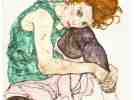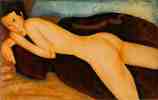
This course emphasizes creative innovations in European literature since 1900. Narrative or dramatic will be explored to help us to understand the writer's unique vision of, above all, human relations and the mysteries of personality in the context of the modern world. Through projects and discussions, students will become further acquainted with comparative methods of text analysis. Our syllabus includes the viewing of several European films.

Egon Schiele'sSitting Woman with Legs Drawn Up, 1917. Courtesy of Narodni Galerie, Prague
Borowski, Tadeusz. This Way for the Gas.
Brecht, Bertolt. The Caucasian Chalk Circle.
Camus, Albert. The Stranger.
Hesse, Hermann. Steppenwolf.
Sartre, Jean-Paul. No Exit and The Respectful Prostitute.
Duras, Marguerite. The Lover and Blue Eyes, Black Hair.

Amedeo Modigliani's Nu couché de dos, 1917. Courtesy of the Barnes Foundation.
"1900"
A star-studded cast, including Robert De Niro, Burt Lancaster, and Gerald Depardieu, tells a panoramic story of two men, both born in 1900, who live very different lives in Italy during a period of social and political upheaval.
"Europa, Europa"
Agnieszka Holland's 1991 German, Russian and Polish film features Marco Hofschneider and Julie Delpy. This true story of a Jewish teenager, who survived World War II by living as a Nazi for 7 years in 3 countries, is based on the memoirs of Salomon Perel.
"Blood Wedding"
Flamenco interpretation of the classic drama by Federico García Lorca in a 1981 motion picture featuring Antonio Gades and Cristina Hoyos. The National Ballet of Spain dances the story of murderous passion and revenge. A young bride runs off from her wedding with a married lover. Her jilted husband tracks them down and fights a knife duel to the death.
"Ashes and Diamonds"
Film adaptation of Jerzy Adrzejewski's 1948 Polish novel that gives a glimpse of post-World War II, where "the world of the victorious had . . . been divided into victors and vanquished."
"Memory of the Camps"
Frontline Series. Documentary footage filmed by Allied Forces army cameramen when they entered the Nazi death camps in 1945 and only recently discovered in the archives of the Imperial War Museum in London. Scenes of the gas chambers, the crematoria, and the starving, haunted survivors in Bergen-Belson, Dachau, Buchenwald, and other camps.
"The Lover"
Film adaptation of Duras' semi-autobiographical novel. According to one internet source: "It is French Colonial Vietnam in 1929. A young French girl from a family that is having some monetary difficulties is returning to boarding school. She is alone on public transportation when she catches the eye of a wealthy Chinese businessman. He offers her a ride into town in the back of his chauffeured sedan, and sparks fly. Can the torrid affair that ensues between them overcome the class restrictions and social mores of that time?"